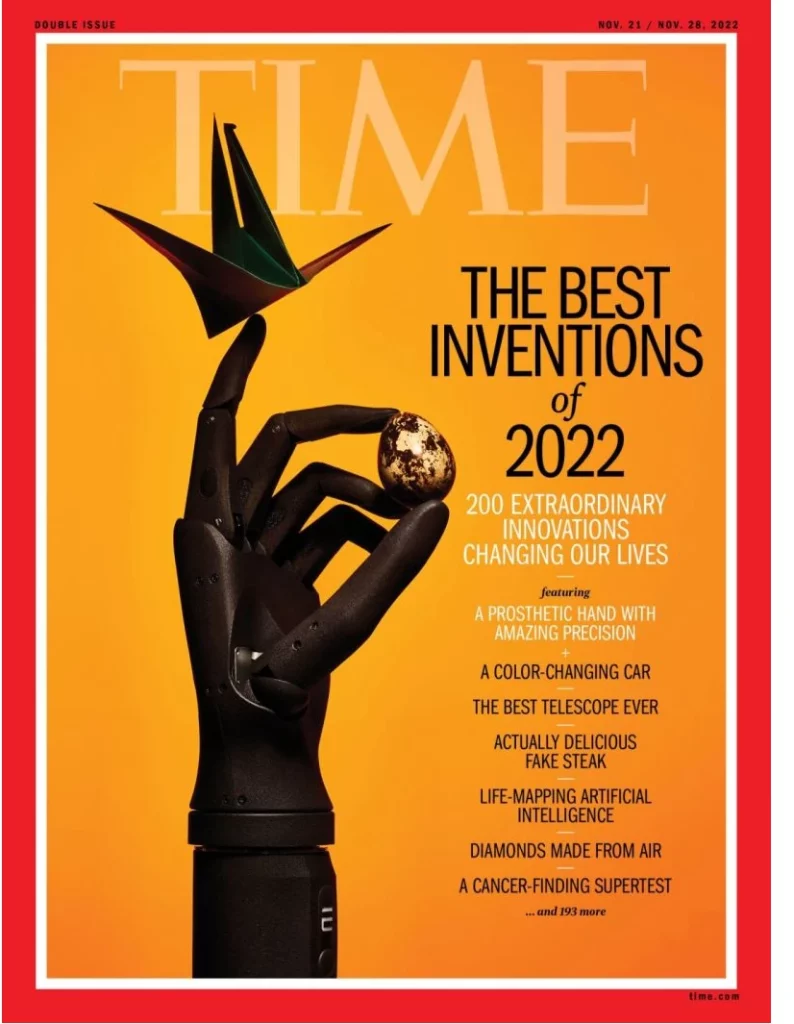
What a year 2022 has been for Esper Bionics and its red-hot prosthetic hand. It started out back in January with a high-profile showcase at the Consumer Electronics Show. Then the product won a prestigious Red Dot Award, followed by recognition as a finalist (one of just six) in Fast Company‘s Innovation by Design Awards. While all this was happening, the city where Esper was founded—Kyiv—was taking rocket fire from the Russian Army, and the company (now headquartered in New York) was shipping devices back home to help Ukrainians who lost arms in the conflict.
Somehow, the company still had the bandwidth to launch clinical trials of its prosthesis, paving the way (it hopes) for FDA approval in the near future. After all that, you might think ending up on the cover of Time Magazine‘s annual “Best Inventions” issue was sort of an anticlimax. Hardly. “Seeing the Esper hand on the cover of Time representing the whole list of groundbreaking inventions is a great honor for the Esper team,” company CEO and co-founder Dima Gazda said in a press release.
Time‘s entire blurb about the product only runs 112 words, so there’s a lot that’s left out. Read on to fill in a few blanks about this high-flying device and the people behind it. Visit the company online at esperbionics.com.
1. It’s one of the few prosthetic-tech products from a woman-led company.
Technically, chief operating officer Anna Believantseva sits second on Esper’s org chart, one rung below CEO Gazda. But as one of the company’s two co-founders, she’s as responsible as anyone for the product’s meteoric rise from initial prototype to Time cover in less than three years. It may not be a coincidence that the Esper hand has won raves for its aesthetic appeal. “Its technically elegant appearance makes the prosthesis a lifestyle product that the user wears with confidence,” wrote the Red Dot jury. “In addition, the design ensures gender-specific shaping by sensitively addressing anatomical differences.” In an interview that appeared in Authority Magazine, Believantseva added: “The first thing it helps people with is socialization. Before Esper Bionics, our users wouldn’t socialize as much as they would want to. Thanks to Esper, they are much more open to the world.”
2. It’s just a first step toward a much broader vision regarding human augmentation.
“We saw this field as the birthplace of the technology stack necessary to introduce the most important technology of the future decades—electronic implants,” Gazda told the tech news site Unite.ai. “We have created something much bigger than an AI-powered hand prosthesis. We have built the first-of-its-kind data-driven bionic ecosystem, [which] currently consists of a software-powered robotic hand prosthesis, a cloud-based platform that uses machine learning algorithms to improve and personalize the control of the prosthesis, and a non-invasive system of muscle action detectors that allow translating signals from the user’s brain into the movements of the robotic hand.” Believantseva adds: “We see the prosthetics industry as the birthplace of technologies that will give humans more abilities, get rid of diseases, and help people live longer and more fulfilling lives.”
3. Facebook’s algorithm helped Gazda settle on a prosthesis for the firm’s debut product.
“When we were researching human augmentation technologies in 2017,” Gazda told Unite.ai, “Facebook suddenly suggested befriending a girl amputee whom I first met in 2006. She lost her hand in a car accident. Although, originally she was from Ukraine—just like I am—we met in Finland. Seeing her on Facebook 11 years later made me think of prosthetics and steered our research toward this field.”
4. An engineer once lost the only existing prototype of the hand.
Back in early 2020, Gazda and Believantseva directed Esper’s operations from Kyiv while chief technology officer Ihor Ilchenko led the engineering team in a different Ukrainian city. After months of feverish work, the tech team produced a working prototype, and Ilchenko bought a rail ticket to Kyiv and hopped aboard with the device—the only one in existence. When he stepped onto the platform at the Kyiv station, he left the prototype on the luggage rack. “Luckily he was able to track it down,” Believantseva told Authority, “but that was an unforgettable experience for all of us.”
5. Esper’s next product will be a lower-limb prosthesis.
“We are getting many requests to start developing leg prostheses, which we expect to start doing by early 2023,” Believantseva told Authority. “After that, we will have enough expertise to start developing electronic implants.” Gazda adds: “We will continue expanding the range of our products to improve the lives of even more amputees, create the biggest community of users of large wearables, and, ultimately, help billions of people by introducing electronic implants.”